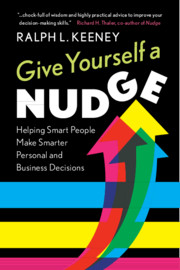Book contents
- Reviews
- Give Yourself a Nudge
- Give Yourself a Nudge
- Copyright page
- Dedication
- Contents
- Preface
- Acknowledgments
- 1 Nudge Yourself to Make Better Decisions
- 2 Your Decisions and Your Life
- 3 Making Value-Focused Decisions
- 4 Defining Your Decision
- 5 Identifying Your Values
- 6 Creating Alternatives
- 7 Identifying Decision Opportunities
- 8 Obtaining Authorization to Select Alternatives Controlled by Others
- 9 Becoming a Value-Focused Decision-Maker
- 10 Enhancing the Quality of Your Life
- 11 Useful Perspectives on Decision-Making
- Appendix Evaluating Alternatives and Making a Decision
- Notes
- Index
5 - Identifying Your Values
Published online by Cambridge University Press: 17 April 2020
- Reviews
- Give Yourself a Nudge
- Give Yourself a Nudge
- Copyright page
- Dedication
- Contents
- Preface
- Acknowledgments
- 1 Nudge Yourself to Make Better Decisions
- 2 Your Decisions and Your Life
- 3 Making Value-Focused Decisions
- 4 Defining Your Decision
- 5 Identifying Your Values
- 6 Creating Alternatives
- 7 Identifying Decision Opportunities
- 8 Obtaining Authorization to Select Alternatives Controlled by Others
- 9 Becoming a Value-Focused Decision-Maker
- 10 Enhancing the Quality of Your Life
- 11 Useful Perspectives on Decision-Making
- Appendix Evaluating Alternatives and Making a Decision
- Notes
- Index
Summary
The reason for making any decision is that you care about making something better. Identifying your values specifies what you care about regarding that decision. Articulating all of the values for a decision is difficult; numerous experiments indicate that half the values for an important decision are not recognized by the decision-maker. This chapter provides a process to stimulate the thoughts of the decision-maker to create a more complete set of values. Each identified value should be stated as an objective, which clarifies what you want to achieve by making that decision. The format for an objective is a noun–verb combination, such as “minimize cost&”or “enhance safety.&”Objectives should then be organized using means–ends relationships, where achievement in terms of a means objective influences the achievement of an ends relationship. This process results in identification of the fundamental objectives, which indicate ultimately what you want to achieve by making the decision, and provides a logically sound basis for evaluating alternatives. Numerous applications indicating the concepts and uses are presented.
Keywords
- Type
- Chapter
- Information
- Give Yourself a NudgeHelping Smart People Make Smarter Personal and Business Decisions, pp. 49 - 79Publisher: Cambridge University PressPrint publication year: 2020

